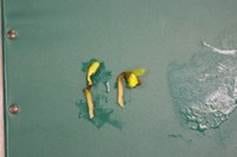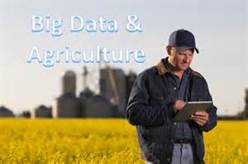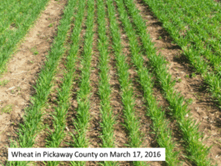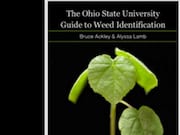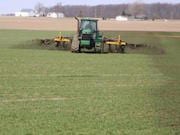Good afternoon,
Driving around the county, I have seen some corn planting that has taken place. Now is the ideal time to plant corn in northwestern Ohio if the soil temperature is above 50 degrees and the fields are fit. The optimal planting date window of April 25-May 10 allows plants to take advantage of longer periods of daylight, pollinate earlier, and mature before a killing frost. Daylight lengthens from the first day of spring (March 21st) until the first day of summer (June 21st). After the first day of summer, day length gradually becomes shorter. Photosynthesis will be more active during these longer days, gathering more energy to put in grain. This stored energy will allow for more kernels per ear to develop – thus the sooner the plant gets started the greater chance to accumulate more energy. This information was taken from a Corn Planting Date article written by OSU Extension Educator Ed Lentz from Hancock County and I have attached the article to this newsletter. Check it out for more tips about corn planting dates and hybrid maturity selection.
Corn Planting Date News Release
OSU Extension newsletters have started up again this growing season that might interest you if you would like to subscribe to them. The Crop Observation and Recommendation Network (CORN) newsletter is now coming out weekly. You can go to www.corn.osu.edu and read it online or subscribe to it directly to have it delivered to your mailbox as soon as the timely information goes out. It is put together each week after our Agronomic Crops Team conference calls, so you can get a jump on what to expect in the fields. Also coming out on a weekly basis now is the VegNet newsletter. Go to http://vegnet.osu.edu/newsletter to read it online or subscribe to it directly to get the latest information provided by the Vegetable and Fruit Crops Teams. If you are interested in up to date horticulture information, go to http://bygl.osu.edu/ to read the Buckeye Yard & Garden onLine (BYGL), or subscribe to get the latest updates as soon as they are released from the Extension, Nursery, Landscape, Turf (ENLT) Team.
What is there to do on a rainy day or when the fields are too wet to work? Consider nominating a family for the Ohio Farmer magazine and Ohio Farm Bureau Federation’s Ohio Conservation Farm Family Awards. This program recognizes farmers who are doing an outstanding job of protecting and conserving soil, water and related natural resources on the land they farm. Coordinated by the Ohio Department of Agriculture, Division of Soil and Water Conservation and co-sponsored by Ohio Farmer magazine and the Ohio Farm Bureau Federation, the program emphasizes the application of technically sound, innovative and cost-effective conservation practices. The deadline for submitting an application is May 20. Hopefully someone from Hardin County will be recognized this year. I have attached the application for your consideration.
See below for agronomy articles that might be of interest to you.
Mark
Temperatures are Still Cool (They were on March 21 – good article though) – Anne Dorrance, Pierce Paul
Cool, wet soils promote the growth of one of the major seed and seedling pathogens of corn and soybean, Pythium. Some of the more than 25 different species of Pythium are particularly favored by these cooler temperatures. Since the soil is moist, oospores which overwinter, are germinating. When the soils become saturated, they will form a structure called a sporangium which forms the zoospores. What is unique about this group of pathogens compared to watermolds is that these spores will then swim to the roots, they are actually attracted to germinating seeds and growing roots. Go to http://agcrops.osu.edu/newsletter/corn-newsletter/temperatures-are-still-cool to finish reading this article.
The Big Data Confusion: Part 3 – Ownership – John Fulton, Kaylee Port
This week’s topic in “The Big Data Confusion” series touches on the importance of data ownership. According to the Privacy and Security Principles for Farm Data, “We believe farmers own information generated on their farming operation. However, it is the responsibility of the farmer to agree upon data use and sharing with other stakeholders that have an economic interest, such as a tenant, landowner, cooperative, agriculture technology provider (ATP), etc. The farmer contracting with the ATP is responsible for ensuring that only the data they own or have permissions to use is included in the account with the ATP.” While it seems that the utilization of data from a farm management aspect is a helpful idea, the problem occurs when it’s time to determine who owns that data and who can use it for their own benefit. To read more about Big Data, go to http://agcrops.osu.edu/newsletter/corn-newsletter/big-data-confusion-part-3-ownership.
Winter Wheat Progress and Management – Laura Lindsey, Ed Lentz, Pierce Paul, Mark Loux
On March 16 and 17, we visited our wheat trials in Clark County and Pickaway County. Both locations were at Feekes growth stage 5 (leaf sheath erect). In northwest Ohio, wheat is at green-up to Feekes growth stage 4. Generally, Feekes growth stage 6 occurs in southern Ohio during early April; however, with abnormally warm temperatures, Feekes growth stage 6 (jointing) may occur sooner. To evaluate wheat for growth stage 6 follow these steps: Pull, or better yet, dig up, several clusters of tillers with roots and soil from multiple locations in the field; Identify and select three to four primary tillers from each cluster – usually the largest tillers with the thickest stem, but size can be deceiving; Strip away and remove all the lower leaves (usually small and yellowish or dead leaves), exposing the base of the stem; Now look for the first node generally between 1 and 2 inches above the base of the stem. This node is usually seen as a slightly swollen area of a slightly different (darker) shade of green than the rest of the stem. To learn more about evaluating wheat growth stages, go to http://agcrops.osu.edu/newsletter/corn-newsletter/winter-wheat-progress-and-management.
Soybean Cyst Nematode CAN be Done in the Spring – Anne Dorrance
These fluctuating temperatures that we have had this spring where we go from snow days to short days provides some opportunities to get the crews out and enjoy some nice weather. Sampling for Soybean Cyst Nematode is fine to do in the spring, especially in years where the ground thaws early. It is becoming increasingly important in Ohio to know your numbers. Sounds like a cholesterol warning doesn’t it? In the case of SCN, less than 500 eggs per cup of soil and keeping it under 1,000 is what we need to shoot for on some fields. Non-detectable levels are like gold. If you are interested in testing for soybean cyst nematode, go to http://agcrops.osu.edu/newsletter/corn-newsletter/soybean-cyst-nematode-can-be-done-spring to find out how.
Timing of Vertical Tillage and Herbicide Applications – Mark Loux
One of the questions that has come up repeatedly over the past year or so concerns the appropriate order of vertical tillage versus herbicide application in the spring. Two general principles guide our thinking on this issue: 1) if possible, foliar burndown herbicides should be applied to undisturbed weeds that are not partially or fully covered with soil; and 2) residual herbicides should left on the surface undisturbed by tillage (allowing rain to move herbicide into the soil) following application unless that tillage will uniformly mix herbicide with the upper couple inches of soil. To finish reading about timing vertical tillage and herbicide applications, go to http://agcrops.osu.edu/newsletter/corn-newsletter/timing-vertical-tillage-and-herbicide-applications.
Mark A. Badertscher
Agriculture and Natural Resources Educator
OSU Extension Hardin County
1021 W. Lima Street, Suite 103, Kenton, OH 43326
419-674-2297 Office
